Training, Development, and Performance Management Assignment Questions
VerifiedAdded on 2019/09/21
|12
|2000
|26
Homework Assignment
AI Summary
This assignment presents a comprehensive set of multiple-choice questions covering key aspects of training, development, and performance management within the realm of Human Resource Management (HRM). The questions delve into various training methods, including apprenticeship and on-the-job training, and explore performance appraisal techniques such as graphic rating scales, forced distribution, and critical incidents. The assessment also addresses organizational development, management development, and career development, including topics like succession planning, career workshops, and alternative work arrangements. The questions assess understanding of concepts like needs analysis, task analysis, goal setting, and performance management processes, providing a thorough review of essential HRM principles.
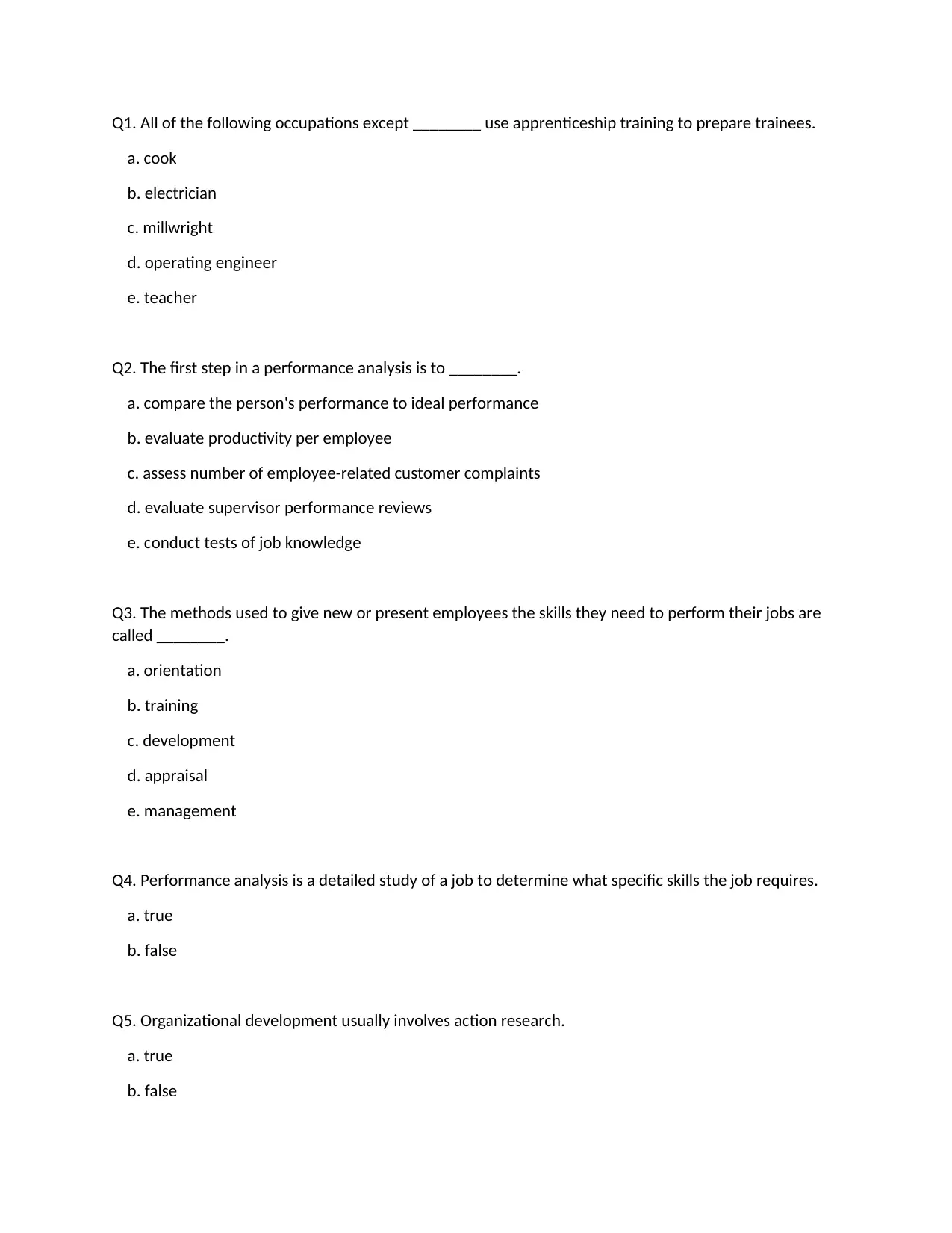
Q1. All of the following occupations except ________ use apprenticeship training to prepare trainees.
a. cook
b. electrician
c. millwright
d. operating engineer
e. teacher
Q2. The first step in a performance analysis is to ________.
a. compare the person's performance to ideal performance
b. evaluate productivity per employee
c. assess number of employee-related customer complaints
d. evaluate supervisor performance reviews
e. conduct tests of job knowledge
Q3. The methods used to give new or present employees the skills they need to perform their jobs are
called ________.
a. orientation
b. training
c. development
d. appraisal
e. management
Q4. Performance analysis is a detailed study of a job to determine what specific skills the job requires.
a. true
b. false
Q5. Organizational development usually involves action research.
a. true
b. false
a. cook
b. electrician
c. millwright
d. operating engineer
e. teacher
Q2. The first step in a performance analysis is to ________.
a. compare the person's performance to ideal performance
b. evaluate productivity per employee
c. assess number of employee-related customer complaints
d. evaluate supervisor performance reviews
e. conduct tests of job knowledge
Q3. The methods used to give new or present employees the skills they need to perform their jobs are
called ________.
a. orientation
b. training
c. development
d. appraisal
e. management
Q4. Performance analysis is a detailed study of a job to determine what specific skills the job requires.
a. true
b. false
Q5. Organizational development usually involves action research.
a. true
b. false
Paraphrase This Document
Need a fresh take? Get an instant paraphrase of this document with our AI Paraphraser
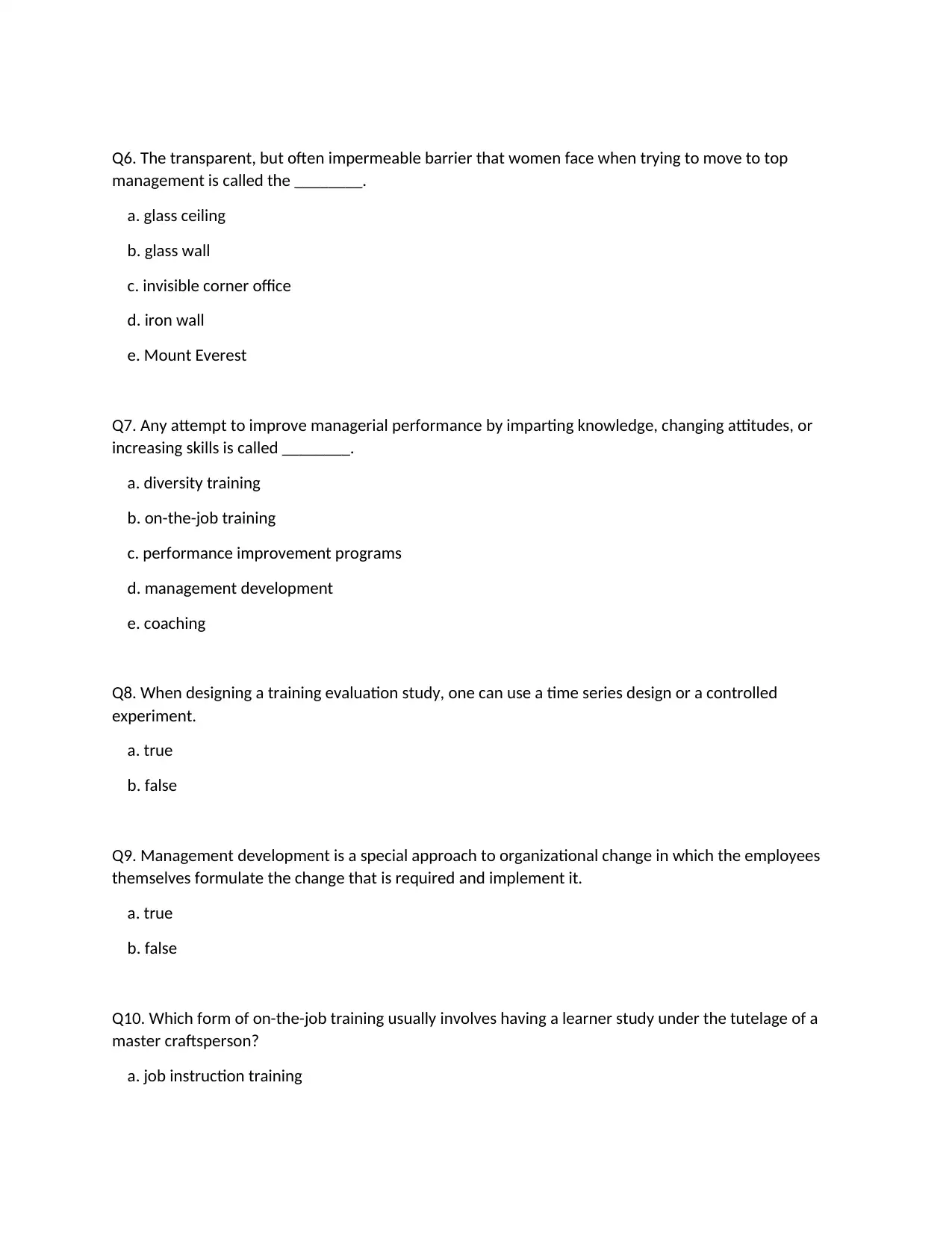
Q6. The transparent, but often impermeable barrier that women face when trying to move to top
management is called the ________.
a. glass ceiling
b. glass wall
c. invisible corner office
d. iron wall
e. Mount Everest
Q7. Any attempt to improve managerial performance by imparting knowledge, changing attitudes, or
increasing skills is called ________.
a. diversity training
b. on-the-job training
c. performance improvement programs
d. management development
e. coaching
Q8. When designing a training evaluation study, one can use a time series design or a controlled
experiment.
a. true
b. false
Q9. Management development is a special approach to organizational change in which the employees
themselves formulate the change that is required and implement it.
a. true
b. false
Q10. Which form of on-the-job training usually involves having a learner study under the tutelage of a
master craftsperson?
a. job instruction training
management is called the ________.
a. glass ceiling
b. glass wall
c. invisible corner office
d. iron wall
e. Mount Everest
Q7. Any attempt to improve managerial performance by imparting knowledge, changing attitudes, or
increasing skills is called ________.
a. diversity training
b. on-the-job training
c. performance improvement programs
d. management development
e. coaching
Q8. When designing a training evaluation study, one can use a time series design or a controlled
experiment.
a. true
b. false
Q9. Management development is a special approach to organizational change in which the employees
themselves formulate the change that is required and implement it.
a. true
b. false
Q10. Which form of on-the-job training usually involves having a learner study under the tutelage of a
master craftsperson?
a. job instruction training
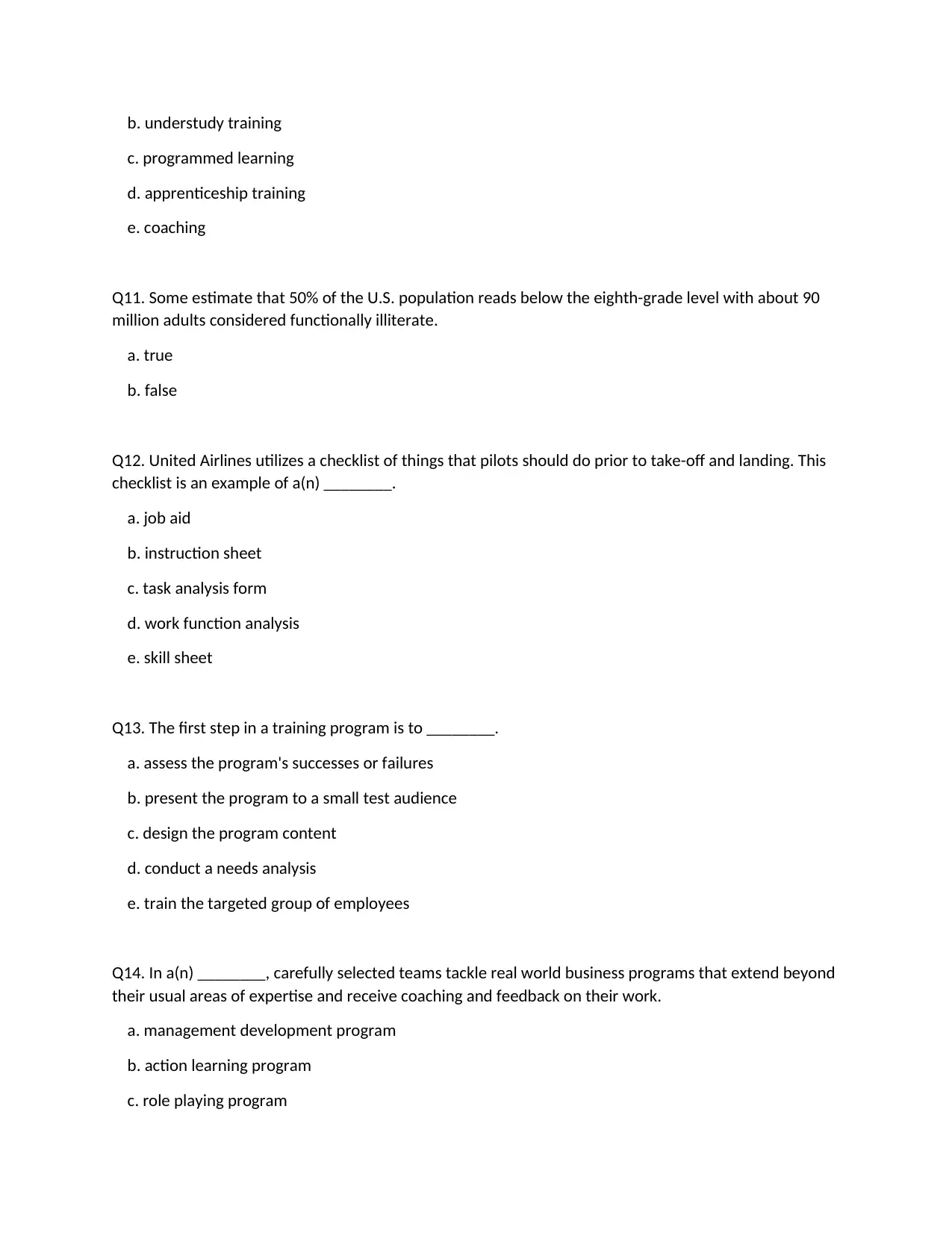
b. understudy training
c. programmed learning
d. apprenticeship training
e. coaching
Q11. Some estimate that 50% of the U.S. population reads below the eighth-grade level with about 90
million adults considered functionally illiterate.
a. true
b. false
Q12. United Airlines utilizes a checklist of things that pilots should do prior to take-off and landing. This
checklist is an example of a(n) ________.
a. job aid
b. instruction sheet
c. task analysis form
d. work function analysis
e. skill sheet
Q13. The first step in a training program is to ________.
a. assess the program's successes or failures
b. present the program to a small test audience
c. design the program content
d. conduct a needs analysis
e. train the targeted group of employees
Q14. In a(n) ________, carefully selected teams tackle real world business programs that extend beyond
their usual areas of expertise and receive coaching and feedback on their work.
a. management development program
b. action learning program
c. role playing program
c. programmed learning
d. apprenticeship training
e. coaching
Q11. Some estimate that 50% of the U.S. population reads below the eighth-grade level with about 90
million adults considered functionally illiterate.
a. true
b. false
Q12. United Airlines utilizes a checklist of things that pilots should do prior to take-off and landing. This
checklist is an example of a(n) ________.
a. job aid
b. instruction sheet
c. task analysis form
d. work function analysis
e. skill sheet
Q13. The first step in a training program is to ________.
a. assess the program's successes or failures
b. present the program to a small test audience
c. design the program content
d. conduct a needs analysis
e. train the targeted group of employees
Q14. In a(n) ________, carefully selected teams tackle real world business programs that extend beyond
their usual areas of expertise and receive coaching and feedback on their work.
a. management development program
b. action learning program
c. role playing program
⊘ This is a preview!⊘
Do you want full access?
Subscribe today to unlock all pages.

Trusted by 1+ million students worldwide
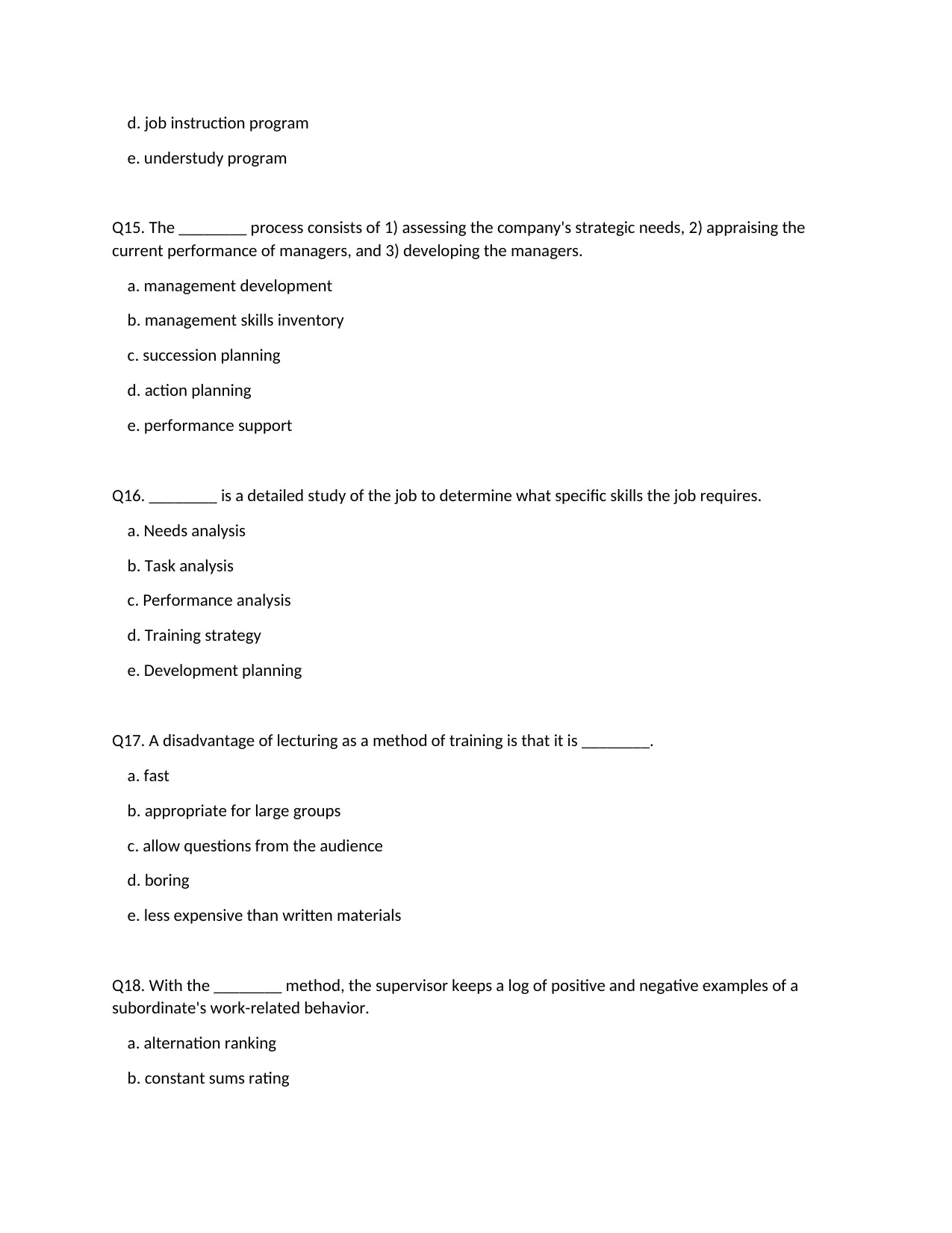
d. job instruction program
e. understudy program
Q15. The ________ process consists of 1) assessing the company's strategic needs, 2) appraising the
current performance of managers, and 3) developing the managers.
a. management development
b. management skills inventory
c. succession planning
d. action planning
e. performance support
Q16. ________ is a detailed study of the job to determine what specific skills the job requires.
a. Needs analysis
b. Task analysis
c. Performance analysis
d. Training strategy
e. Development planning
Q17. A disadvantage of lecturing as a method of training is that it is ________.
a. fast
b. appropriate for large groups
c. allow questions from the audience
d. boring
e. less expensive than written materials
Q18. With the ________ method, the supervisor keeps a log of positive and negative examples of a
subordinate's work-related behavior.
a. alternation ranking
b. constant sums rating
e. understudy program
Q15. The ________ process consists of 1) assessing the company's strategic needs, 2) appraising the
current performance of managers, and 3) developing the managers.
a. management development
b. management skills inventory
c. succession planning
d. action planning
e. performance support
Q16. ________ is a detailed study of the job to determine what specific skills the job requires.
a. Needs analysis
b. Task analysis
c. Performance analysis
d. Training strategy
e. Development planning
Q17. A disadvantage of lecturing as a method of training is that it is ________.
a. fast
b. appropriate for large groups
c. allow questions from the audience
d. boring
e. less expensive than written materials
Q18. With the ________ method, the supervisor keeps a log of positive and negative examples of a
subordinate's work-related behavior.
a. alternation ranking
b. constant sums rating
Paraphrase This Document
Need a fresh take? Get an instant paraphrase of this document with our AI Paraphraser
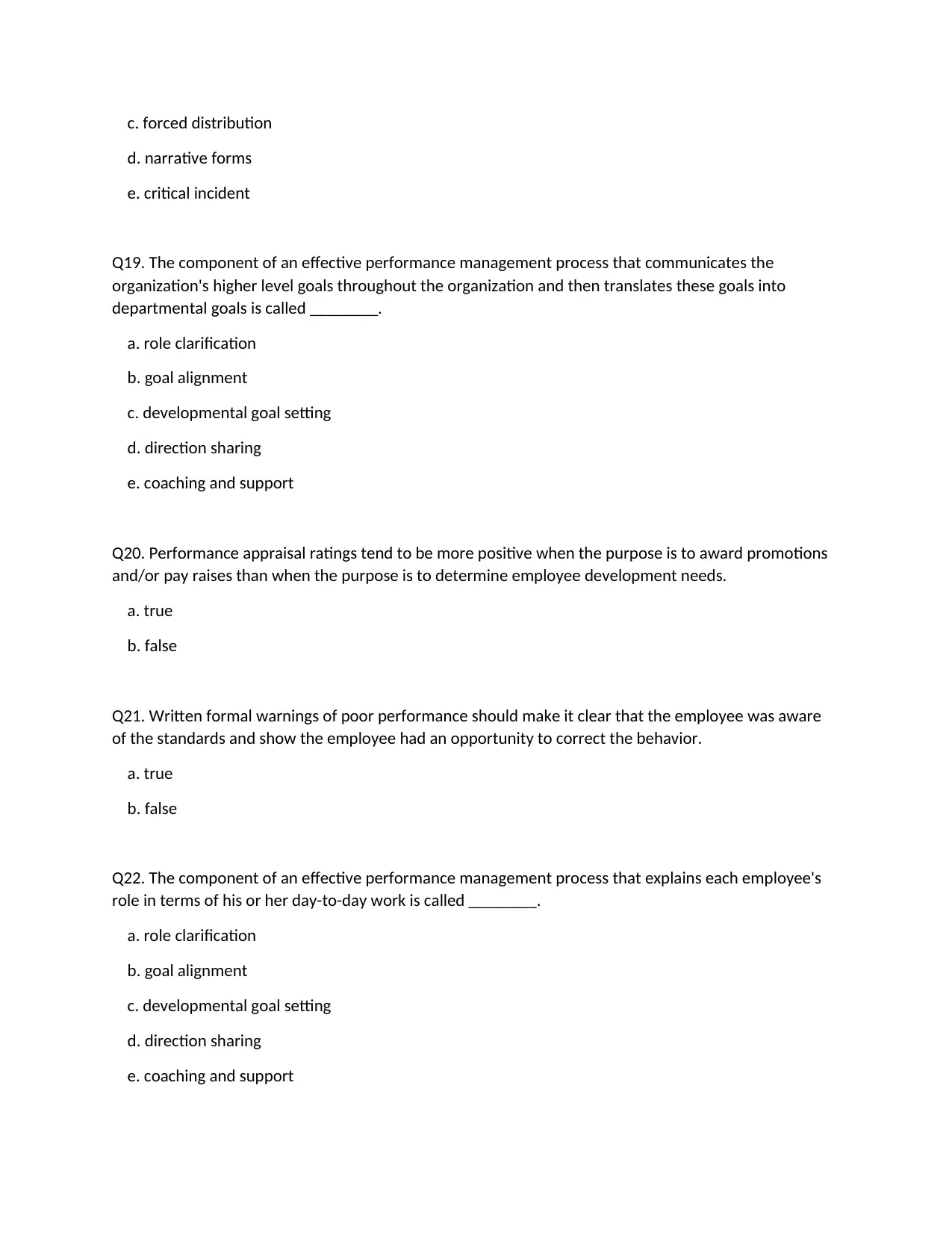
c. forced distribution
d. narrative forms
e. critical incident
Q19. The component of an effective performance management process that communicates the
organization's higher level goals throughout the organization and then translates these goals into
departmental goals is called ________.
a. role clarification
b. goal alignment
c. developmental goal setting
d. direction sharing
e. coaching and support
Q20. Performance appraisal ratings tend to be more positive when the purpose is to award promotions
and/or pay raises than when the purpose is to determine employee development needs.
a. true
b. false
Q21. Written formal warnings of poor performance should make it clear that the employee was aware
of the standards and show the employee had an opportunity to correct the behavior.
a. true
b. false
Q22. The component of an effective performance management process that explains each employee's
role in terms of his or her day-to-day work is called ________.
a. role clarification
b. goal alignment
c. developmental goal setting
d. direction sharing
e. coaching and support
d. narrative forms
e. critical incident
Q19. The component of an effective performance management process that communicates the
organization's higher level goals throughout the organization and then translates these goals into
departmental goals is called ________.
a. role clarification
b. goal alignment
c. developmental goal setting
d. direction sharing
e. coaching and support
Q20. Performance appraisal ratings tend to be more positive when the purpose is to award promotions
and/or pay raises than when the purpose is to determine employee development needs.
a. true
b. false
Q21. Written formal warnings of poor performance should make it clear that the employee was aware
of the standards and show the employee had an opportunity to correct the behavior.
a. true
b. false
Q22. The component of an effective performance management process that explains each employee's
role in terms of his or her day-to-day work is called ________.
a. role clarification
b. goal alignment
c. developmental goal setting
d. direction sharing
e. coaching and support
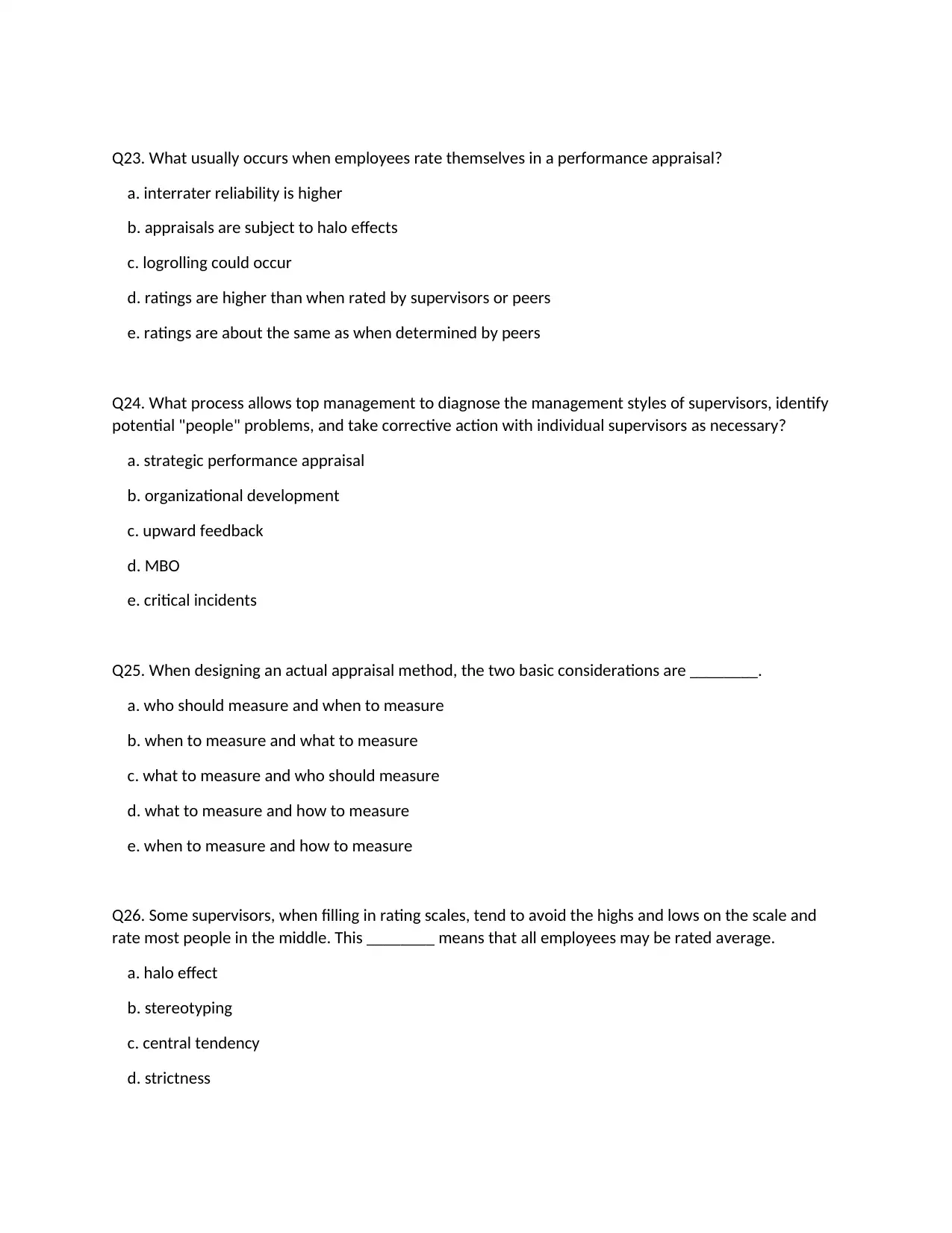
Q23. What usually occurs when employees rate themselves in a performance appraisal?
a. interrater reliability is higher
b. appraisals are subject to halo effects
c. logrolling could occur
d. ratings are higher than when rated by supervisors or peers
e. ratings are about the same as when determined by peers
Q24. What process allows top management to diagnose the management styles of supervisors, identify
potential "people" problems, and take corrective action with individual supervisors as necessary?
a. strategic performance appraisal
b. organizational development
c. upward feedback
d. MBO
e. critical incidents
Q25. When designing an actual appraisal method, the two basic considerations are ________.
a. who should measure and when to measure
b. when to measure and what to measure
c. what to measure and who should measure
d. what to measure and how to measure
e. when to measure and how to measure
Q26. Some supervisors, when filling in rating scales, tend to avoid the highs and lows on the scale and
rate most people in the middle. This ________ means that all employees may be rated average.
a. halo effect
b. stereotyping
c. central tendency
d. strictness
a. interrater reliability is higher
b. appraisals are subject to halo effects
c. logrolling could occur
d. ratings are higher than when rated by supervisors or peers
e. ratings are about the same as when determined by peers
Q24. What process allows top management to diagnose the management styles of supervisors, identify
potential "people" problems, and take corrective action with individual supervisors as necessary?
a. strategic performance appraisal
b. organizational development
c. upward feedback
d. MBO
e. critical incidents
Q25. When designing an actual appraisal method, the two basic considerations are ________.
a. who should measure and when to measure
b. when to measure and what to measure
c. what to measure and who should measure
d. what to measure and how to measure
e. when to measure and how to measure
Q26. Some supervisors, when filling in rating scales, tend to avoid the highs and lows on the scale and
rate most people in the middle. This ________ means that all employees may be rated average.
a. halo effect
b. stereotyping
c. central tendency
d. strictness
⊘ This is a preview!⊘
Do you want full access?
Subscribe today to unlock all pages.

Trusted by 1+ million students worldwide
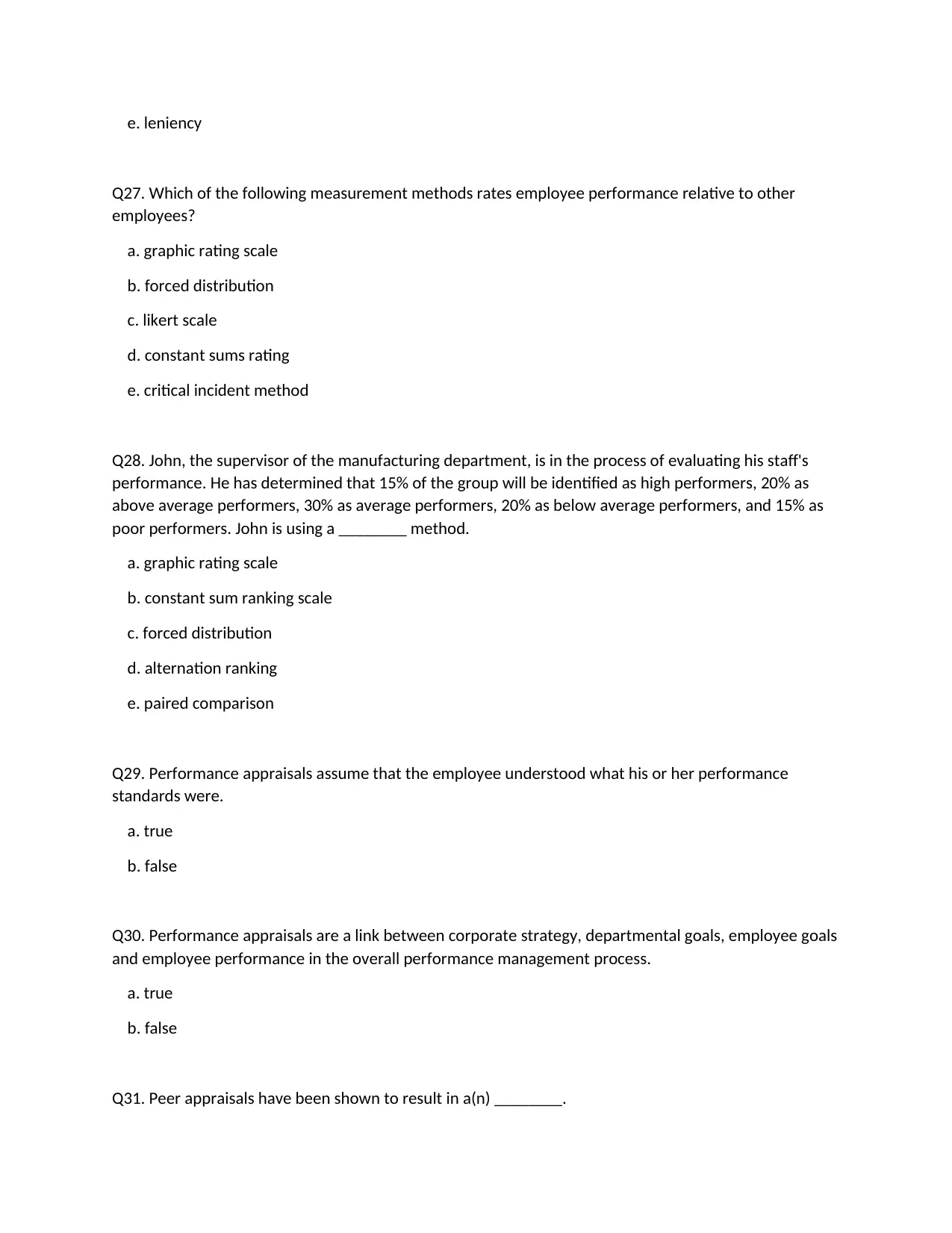
e. leniency
Q27. Which of the following measurement methods rates employee performance relative to other
employees?
a. graphic rating scale
b. forced distribution
c. likert scale
d. constant sums rating
e. critical incident method
Q28. John, the supervisor of the manufacturing department, is in the process of evaluating his staff's
performance. He has determined that 15% of the group will be identified as high performers, 20% as
above average performers, 30% as average performers, 20% as below average performers, and 15% as
poor performers. John is using a ________ method.
a. graphic rating scale
b. constant sum ranking scale
c. forced distribution
d. alternation ranking
e. paired comparison
Q29. Performance appraisals assume that the employee understood what his or her performance
standards were.
a. true
b. false
Q30. Performance appraisals are a link between corporate strategy, departmental goals, employee goals
and employee performance in the overall performance management process.
a. true
b. false
Q31. Peer appraisals have been shown to result in a(n) ________.
Q27. Which of the following measurement methods rates employee performance relative to other
employees?
a. graphic rating scale
b. forced distribution
c. likert scale
d. constant sums rating
e. critical incident method
Q28. John, the supervisor of the manufacturing department, is in the process of evaluating his staff's
performance. He has determined that 15% of the group will be identified as high performers, 20% as
above average performers, 30% as average performers, 20% as below average performers, and 15% as
poor performers. John is using a ________ method.
a. graphic rating scale
b. constant sum ranking scale
c. forced distribution
d. alternation ranking
e. paired comparison
Q29. Performance appraisals assume that the employee understood what his or her performance
standards were.
a. true
b. false
Q30. Performance appraisals are a link between corporate strategy, departmental goals, employee goals
and employee performance in the overall performance management process.
a. true
b. false
Q31. Peer appraisals have been shown to result in a(n) ________.
Paraphrase This Document
Need a fresh take? Get an instant paraphrase of this document with our AI Paraphraser
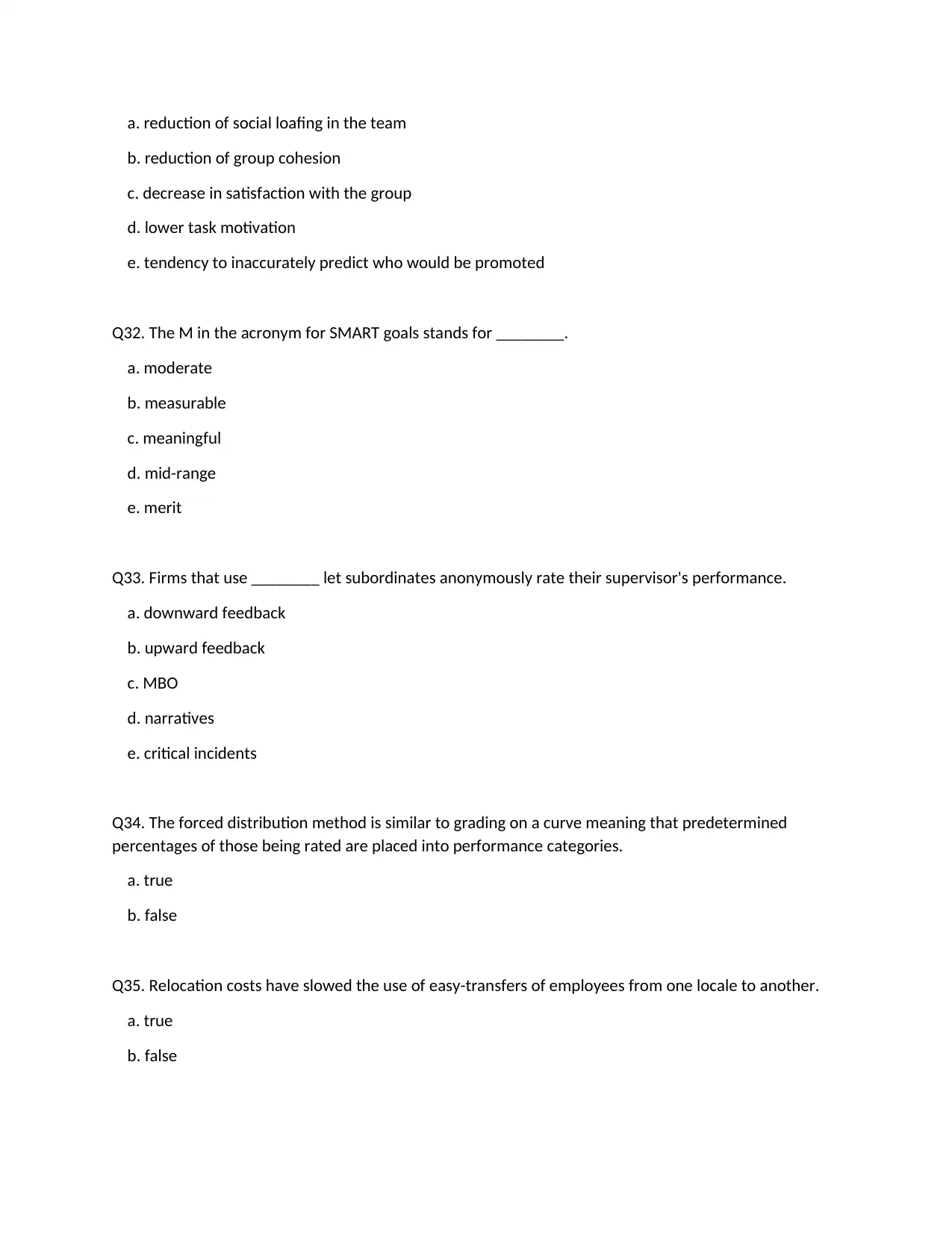
a. reduction of social loafing in the team
b. reduction of group cohesion
c. decrease in satisfaction with the group
d. lower task motivation
e. tendency to inaccurately predict who would be promoted
Q32. The M in the acronym for SMART goals stands for ________.
a. moderate
b. measurable
c. meaningful
d. mid-range
e. merit
Q33. Firms that use ________ let subordinates anonymously rate their supervisor's performance.
a. downward feedback
b. upward feedback
c. MBO
d. narratives
e. critical incidents
Q34. The forced distribution method is similar to grading on a curve meaning that predetermined
percentages of those being rated are placed into performance categories.
a. true
b. false
Q35. Relocation costs have slowed the use of easy-transfers of employees from one locale to another.
a. true
b. false
b. reduction of group cohesion
c. decrease in satisfaction with the group
d. lower task motivation
e. tendency to inaccurately predict who would be promoted
Q32. The M in the acronym for SMART goals stands for ________.
a. moderate
b. measurable
c. meaningful
d. mid-range
e. merit
Q33. Firms that use ________ let subordinates anonymously rate their supervisor's performance.
a. downward feedback
b. upward feedback
c. MBO
d. narratives
e. critical incidents
Q34. The forced distribution method is similar to grading on a curve meaning that predetermined
percentages of those being rated are placed into performance categories.
a. true
b. false
Q35. Relocation costs have slowed the use of easy-transfers of employees from one locale to another.
a. true
b. false

Q36. If an employer offers to add information about individual interests and preferences to its employee
database, it is encouraging a career development focus to the human resource activity focused on
________.
a. human resource planning
b. training and development
c. performance appraisal
d. recruiting and placement
e. compensation and benefits
Q37. What type of preretirement education program is offered most often?
a. explanation of social security benefits
b. leisure time counseling
c. health counseling
d. counseling for second careers outside the company
e. psychological counseling
Q38. How do compensation and benefits with a career development focus differ from compensation
and benefits with a traditional focus?
a. productivity is rewarded
b. non-job-related activities are included in those to be rewarded
c. talent is rewarded
d. time is rewarded
e. there is no difference
Q39. ________ is aimed at helping employees ease the transition from working to retirement.
a. Preretirement counseling
b. Performance management
c. Retirement planning
d. Flextime
e. Downtime
database, it is encouraging a career development focus to the human resource activity focused on
________.
a. human resource planning
b. training and development
c. performance appraisal
d. recruiting and placement
e. compensation and benefits
Q37. What type of preretirement education program is offered most often?
a. explanation of social security benefits
b. leisure time counseling
c. health counseling
d. counseling for second careers outside the company
e. psychological counseling
Q38. How do compensation and benefits with a career development focus differ from compensation
and benefits with a traditional focus?
a. productivity is rewarded
b. non-job-related activities are included in those to be rewarded
c. talent is rewarded
d. time is rewarded
e. there is no difference
Q39. ________ is aimed at helping employees ease the transition from working to retirement.
a. Preretirement counseling
b. Performance management
c. Retirement planning
d. Flextime
e. Downtime
⊘ This is a preview!⊘
Do you want full access?
Subscribe today to unlock all pages.

Trusted by 1+ million students worldwide
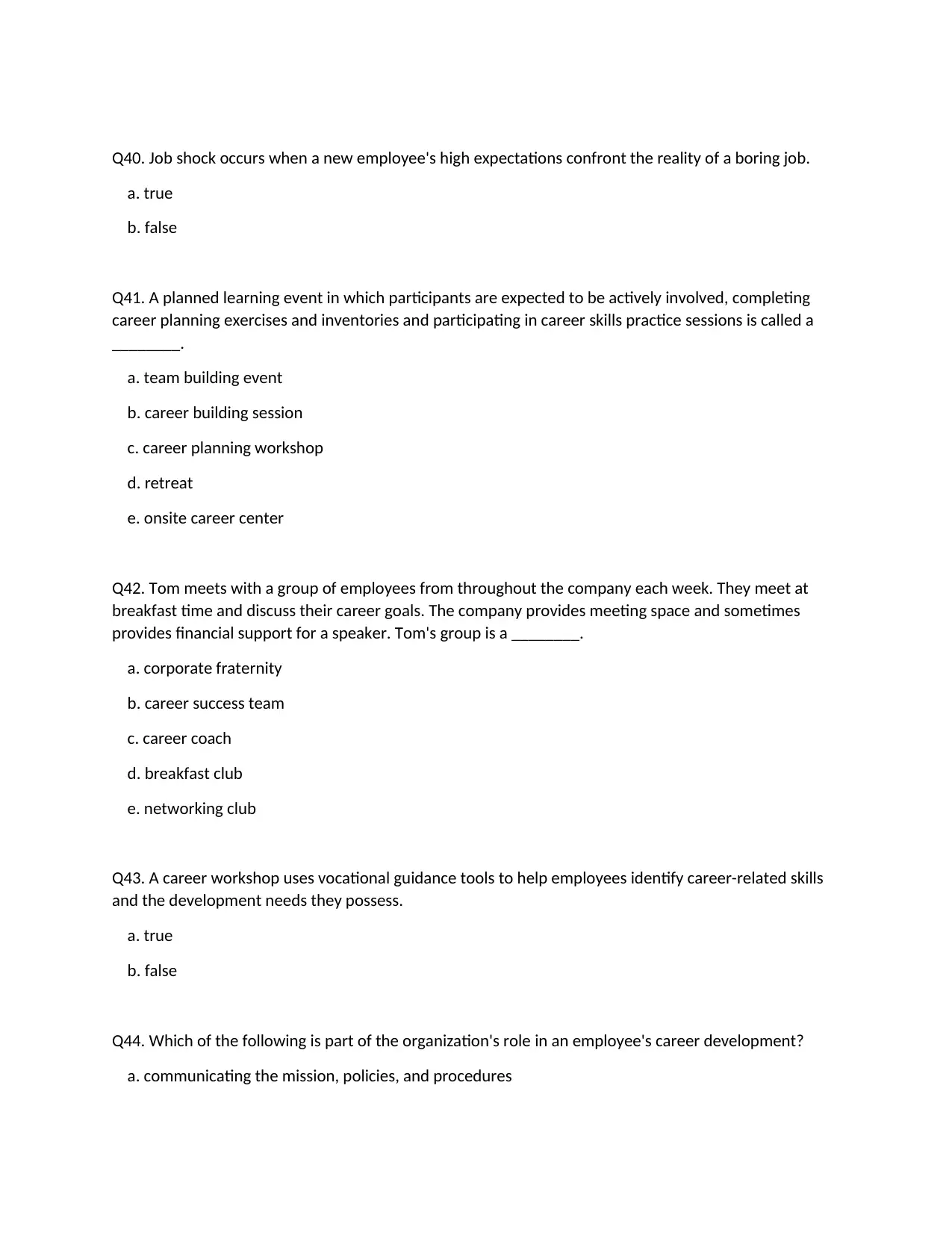
Q40. Job shock occurs when a new employee's high expectations confront the reality of a boring job.
a. true
b. false
Q41. A planned learning event in which participants are expected to be actively involved, completing
career planning exercises and inventories and participating in career skills practice sessions is called a
________.
a. team building event
b. career building session
c. career planning workshop
d. retreat
e. onsite career center
Q42. Tom meets with a group of employees from throughout the company each week. They meet at
breakfast time and discuss their career goals. The company provides meeting space and sometimes
provides financial support for a speaker. Tom's group is a ________.
a. corporate fraternity
b. career success team
c. career coach
d. breakfast club
e. networking club
Q43. A career workshop uses vocational guidance tools to help employees identify career-related skills
and the development needs they possess.
a. true
b. false
Q44. Which of the following is part of the organization's role in an employee's career development?
a. communicating the mission, policies, and procedures
a. true
b. false
Q41. A planned learning event in which participants are expected to be actively involved, completing
career planning exercises and inventories and participating in career skills practice sessions is called a
________.
a. team building event
b. career building session
c. career planning workshop
d. retreat
e. onsite career center
Q42. Tom meets with a group of employees from throughout the company each week. They meet at
breakfast time and discuss their career goals. The company provides meeting space and sometimes
provides financial support for a speaker. Tom's group is a ________.
a. corporate fraternity
b. career success team
c. career coach
d. breakfast club
e. networking club
Q43. A career workshop uses vocational guidance tools to help employees identify career-related skills
and the development needs they possess.
a. true
b. false
Q44. Which of the following is part of the organization's role in an employee's career development?
a. communicating the mission, policies, and procedures
Paraphrase This Document
Need a fresh take? Get an instant paraphrase of this document with our AI Paraphraser

b. providing timely performance feedback
c. participating in career development discussions
d. establishing goals and career plans
e. seeking out career information
Q45. Alternative work arrangements include all of the following except ________.
a. part-time work
b. flexible hours
c. on-site child care
d. telecommuting
e. job sharing
Q46. Smith Industries wants to develop a career track designed to enable women to advance in upper-
level managerial positions. Which of the following suggestions should Smith Industries consider?
a. flexible work schedules
b. training
c. seniority status
d. career success teams
Q47. Women report experiencing barriers to career advancement like all of those listed below except
________.
a. exclusion from informal networks
b. difficulty getting developmental assignments
c. difficulty getting opportunities requiring geographic mobility
d. lack of educational opportunities
e. difficulty balancing work and family life
Q48. Which of the following is part of an employee's role in his or her own career development?
a. communicating the mission, policies, and procedures
c. participating in career development discussions
d. establishing goals and career plans
e. seeking out career information
Q45. Alternative work arrangements include all of the following except ________.
a. part-time work
b. flexible hours
c. on-site child care
d. telecommuting
e. job sharing
Q46. Smith Industries wants to develop a career track designed to enable women to advance in upper-
level managerial positions. Which of the following suggestions should Smith Industries consider?
a. flexible work schedules
b. training
c. seniority status
d. career success teams
Q47. Women report experiencing barriers to career advancement like all of those listed below except
________.
a. exclusion from informal networks
b. difficulty getting developmental assignments
c. difficulty getting opportunities requiring geographic mobility
d. lack of educational opportunities
e. difficulty balancing work and family life
Q48. Which of the following is part of an employee's role in his or her own career development?
a. communicating the mission, policies, and procedures

b. providing timely performance feedback
c. participating in career development discussions
d. establishing goals and career plans
e. offering a variety of career options
Q49. Career coaches help employees to create plans showing where their careers should lead. The
planning time period is usually ________.
a. less than one year
b. 1-5 years
c. 5-10 years
d. 10-15 years
e. equivalent to the number of years the person plans to work
Q50. Assessing interests, seeking out career information, and utilizing development opportunities are all
part of the ________'s role in career development.
a. individual
b. manager
c. supervisor
d. company
e. human resource specialist
c. participating in career development discussions
d. establishing goals and career plans
e. offering a variety of career options
Q49. Career coaches help employees to create plans showing where their careers should lead. The
planning time period is usually ________.
a. less than one year
b. 1-5 years
c. 5-10 years
d. 10-15 years
e. equivalent to the number of years the person plans to work
Q50. Assessing interests, seeking out career information, and utilizing development opportunities are all
part of the ________'s role in career development.
a. individual
b. manager
c. supervisor
d. company
e. human resource specialist
⊘ This is a preview!⊘
Do you want full access?
Subscribe today to unlock all pages.

Trusted by 1+ million students worldwide
1 out of 12
Related Documents
Your All-in-One AI-Powered Toolkit for Academic Success.
+13062052269
info@desklib.com
Available 24*7 on WhatsApp / Email
![[object Object]](/_next/static/media/star-bottom.7253800d.svg)
Unlock your academic potential
Copyright © 2020–2025 A2Z Services. All Rights Reserved. Developed and managed by ZUCOL.





